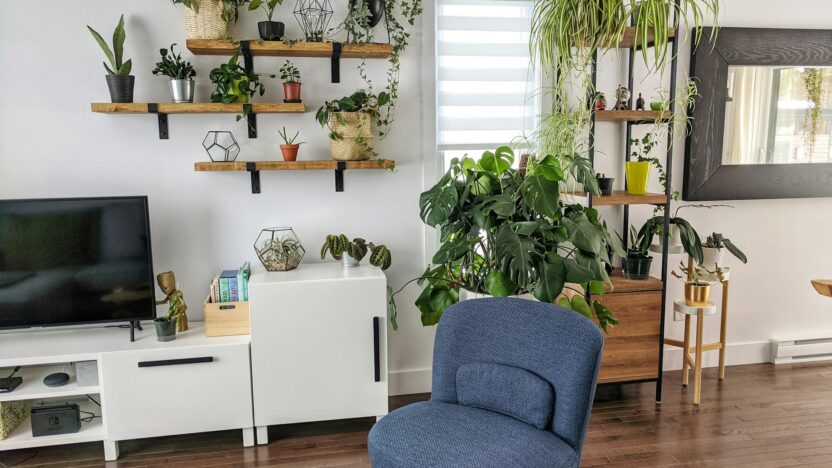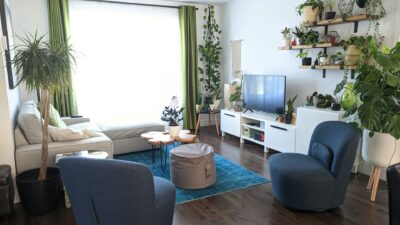Your bedroom should be a restful sanctuary, and making it eco-friendly enhances both your health and the planet’s well-being. Sustainable decor creates a calming space free from harmful chemicals, using materials and practices that reduce environmental impact. From organic bedding to DIY projects, this guide offers practical ways to design a green bedroom that’s cozy and sustainable. For more eco-friendly home ideas, check out For Organic Life.
Organic Bedding Materials
Bedding is the heart of any bedroom, and choosing organic materials ensures comfort without harming the environment. Here are some sustainable options:
- Organic Cotton: Grown without pesticides, it’s soft and breathable. Look for GOTS-certified sheets, duvet covers, or pillowcases.
- Linen: Made from flax, linen is durable, biodegradable, and naturally cooling. It gets softer with each wash.
- Hemp: This eco-friendly fabric is strong, antimicrobial, and requires less water to grow than conventional cotton.
- Bamboo: Choose bamboo bedding from sustainably managed sources. It’s silky and hypoallergenic.
Avoid synthetic bedding like polyester, which is made from petroleum and can release microplastics. Check labels for certifications to ensure your bedding is truly organic. If possible, buy from local or ethical brands to support sustainable practices. Organic bedding promotes better sleep and a healthier planet.
Choosing Non-Toxic Paints and Finishes
The walls and furniture in your bedroom can affect air quality, so opt for non-toxic paints and finishes. Conventional paints often contain volatile organic compounds (VOCs), which release harmful gases. Here’s how to choose greener options:
- Low-VOC or Zero-VOC Paints: These reduce indoor air pollution. Brands like Benjamin Moore Natura or ECOS Paints offer eco-friendly options in various colors.
- Natural Paints: Made from ingredients like clay, lime, or milk, these are biodegradable and safe for sensitive spaces.
- Non-Toxic Wood Finishes: For furniture, use water-based or plant-based stains and sealants, like linseed oil or beeswax.
Before painting, test a small area to ensure the color suits your space. Ventilate the room well during and after painting to minimize fumes. For furniture, sand down old pieces and apply non-toxic finishes to refresh them sustainably. These choices keep your bedroom air clean and your decor green.
DIY Decor Projects for a Sustainable Bedroom
DIY projects add personal charm to your bedroom while reducing waste. Upcycling and crafting with eco-friendly materials are perfect for a sustainable space. Try these ideas:
- Headboard from Reclaimed Wood: Use old barn wood or pallets to create a rustic headboard. Sand and seal with non-toxic finish.
- Macramé Wall Hangings: Make hangings from organic cotton or hemp cord for a boho vibe. Use driftwood as a base for added sustainability.
- Repurposed Nightstands: Turn old crates or suitcases into nightstands by stacking or adding legs. Paint with non-toxic colors.
- Fabric Wall Art: Stretch organic fabric scraps over canvas frames for colorful, eco-friendly art.
Source materials from thrift stores, salvage yards, or your own home to keep costs low. Use non-toxic glues and paints to stay eco-friendly. DIY projects let you customize your bedroom while reducing your environmental footprint.
Energy-Saving Window Treatments
Windows play a big role in your bedroom’s energy efficiency. Sustainable window treatments keep your room comfortable while reducing energy use. Here are some options:
- Organic Cotton Curtains: Lightweight, GOTS-certified cotton curtains allow natural light while insulating against drafts.
- Bamboo Blinds: These are renewable, durable, and add a natural texture. They block heat in summer and retain warmth in winter.
- Cellular Shades: These energy-efficient shades trap air, insulating your room. Choose ones made from recycled materials.
- DIY Draft Stoppers: Sew tubes from organic fabric scraps, fill with rice or sand, and place along window sills to block cold air.
Hang treatments close to windows to maximize insulation. Open curtains during the day to let in natural light, reducing the need for artificial lighting. Energy-saving window treatments lower your carbon footprint and keep your bedroom cozy year-round.
Maintaining a Clutter-Free, Eco-Friendly Space
A clutter-free bedroom promotes relaxation and sustainability. Excess items lead to waste, so embrace minimalism with these tips:
- Declutter Regularly: Keep only essentials like bedding, a few decor pieces, and functional furniture. Donate or recycle items you don’t need.
- Multi-Use Furniture: Choose pieces like a bed with built-in storage or a bench that doubles as a shelf to save space.
- Eco-Friendly Storage: Use baskets made from seagrass or recycled materials instead of plastic bins.
- Quality Over Quantity: Invest in durable, sustainable items that last, like a solid wood bed frame or organic mattress.
Organize items thoughtfully to avoid buying unnecessary decor. For example, store extra blankets in a reclaimed wood chest that doubles as a bench. A tidy, eco-friendly bedroom feels serene and supports your green lifestyle.
Crafting Your Sustainable Retreat
A sustainable bedroom combines comfort, style, and environmental responsibility. By choosing organic bedding, non-toxic paints, DIY decor, energy-saving window treatments, and a clutter-free approach, you can create a restful space that’s kind to the planet. Start with small changes and build your green oasis over time. For more eco-friendly ideas, visit For Organic Life. Enjoy your sustainable, restful bedroom!




